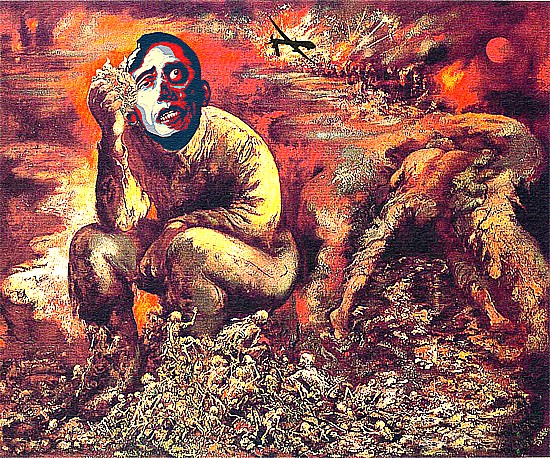I've written more than once in various contexts and words, declaring that war is the antithesis of art. That is, art is creative, war is destructive. War destroys lives, property, morals, wealth, motivation, harmony, and hope. Moreover, it also destroys art and artists, if not literally, then figuratively by engendering a sense of demoralizing hatred and perhaps worse, a desensitized ambivalence to the suffering of others--it's their war, not ours.
 |
Woman with Dead Child, 1903, Kathe Kollwitz.
She lost a son fighting in the war. |
 |
Never Again War, 1924,
Kathe Kollwitz |
German artist
Kathe Kollwitz (above) fled Berlin for a small town near Dresden, (south-eastern) Germany, to continue her anti-war art crusade. (Her studio in Berlin was later destroyed by Allied bombing.) Another German artist,
George Grosz (top), fled Germany during then 1930s to become an American citizen, allowing him to freely render some of the most horrifying visions of war at it's worst in an effort to bring the devastating tragedy occurring in far-away Europe home to the American people, in the hope of stirring an isolationist nation to counter the Nazi juggernaut. And while Picasso did not flee the Nazis when they invaded Paris in 1941, his 1937
Guernica (below) may well be the greatest anti-war painting in the history of art.
 |
| Guernica, 1937, Pablo Picasso |
Anti-war art did not start during the late 1930s with the looming threat of a second world war. It began in the aftermath of the first world war with the Dada movement, though it was then so broadly anti-art, anti-establishment, and anti-traditional that its anti-war sentiments nearly became lost due to its lack of focus. However, with the rise of Hitler in Germany and other regional dictators itching for revenge from the harsh terms imposed upon them by the Treaty of Versailles, there's nothing like the looming shadow of yet another even broader, much more devastating, conflict to hone ones historical concentration. Virtually all the European anti-war artists, though not necessarily
Dadaists, were influenced by the movement.
 |
John Heartfield, 1930s, though German-born, his anti-Nazi
photo montages forced him to flee Germany for London,
decades before there was Photoshop. |
During WW II, the ugly evils of the Third Reich were so morally abhorrent that artists and their art, though doggedly anti-war, also found it imperative to choose sides. Anti-war became anti-German, as exemplified in the photomontages of
John Heartfield (above). That was not the case some twenty years later when anti-war art had matured to the point of having a real political impact. Anti-war art could reasonably be credited with actually
ending a war. This time there was no choosing sides. Anti-war meant just that. Anti-war art fought in the streets of San Francisco, Washington, D.C., Chicago, L.A., and on the college greens of nearly every university in the United States. In combating the inherent patriotic fervor--my country, right or wrong--it was labeled anti-American, left-wing, communist, socialist, and any number of political epithets unfit for mention in an art forum such as this.
 |
The Art Workers Coalition poster And Babies, utilizes a photo
taken in the aftermath of the My Lai massacre. it was by far the most
effective anti-war poster from the era. |
 |
The most iconic of all the
Vietnam anti-war posters. |
During the Vietnam era, anti-war art was no longer limited to painted images of blood and guts combat art, or depictions of suffering, tor-tured, and dying refugees. Photos like the one above had a tremendous impact on the sen-sibilities of the American public. However, such images were far more than "moving." In fact, the most powerful of them actually
moved. Whereas, between the two wars, motion pictures were seen by most art activists as ineffectual novelties, the Russian film maker,
Sergei Eis-enstein, and the American film director, Lewis Milestone, demonstrated with
The Battleship Potemkin (1925) and
All Quiet on the Western Front (1930), the powerful potential motion pictures had in changing the minds of men, and underlining the futility of wars.
 |
| Catch-22, 1970, Mike Nichols |
By the 1960s, there were not just two minor movie experiments in anti-war art, but dozens of them, each one seemingly more effective than the one before. Leading the list would be
Stanley Kubrick's
Dr. Strangelove (1963), followed closely by David Lean's
Bridge on the River Kwai (1957), Mike Nichols'
Catch-22 (1970), British film maker, Joseph Losey's
King and Country (1964), Robert Altman's
M*A*S*H (1970), and many others released both before and after the war. Some employed comedy and were subtle in their protest, many were anything but. Some were, naturally, more popular than others. Yet, each, in their on way, had an impact on the public awareness of the nature of war from which, in the past, they'd been purposely insulated.
 |
King and Country, 1964, Joseph Losey
--the version of an anti-war film. |
While artists may have had a hand in ending the war in Indochina, they did
not end war in general (or
by generals). In the years since Vietnam, the anti-war movements, have been diluted by the absence of the draft. However, they have been bolstered by terrorism, nation building, economic factors, ethnic and religious conflicts, oil, nuclear proliferation, conflicting alliances, and simple political expedience have all served to drastically increase the complexity of various wars, large and small, in the Middle east, Africa, and elsewhere. Anti-war art does not handle complexities well (if at all). Such art strives to simplify, shock, shame, and objectify. In so doing it muddles the differences between right and wrong, and risks becoming inconsequential. Given these complexities, it's tempting to fall back to the old saying a picture (art) is worth a thousand words; but in fact, only rarely does the visual power of even the
best art rise to such a lofty word-count.
Some of the films mentioned above and some others:











No comments:
Post a Comment